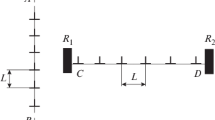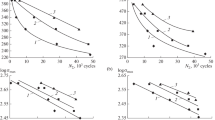Abstract
The effect of low pressures on the fatigue, tensile and creep behavior is discussed. The data are interpreted in terms of the accumulation of dislocations in the surface region. It is suggested that the mechanical behavior is influenced by the rate of escape of dislocations through the surface. Initially, the oxide layer plays an important role; however, as the strain increases, the dislocation layer exerts a large influence.
Similar content being viewed by others
References
Roscoe, R., “Strength of Metal Single Crystals,”Nature, London 133, 912 (1934).
Cottrell, A. H., andGibbons, D. F., “Thermal Hardening of Cadmium Crystals,”Nature, London 162, 488 (1948).
Harper, S., and Cottrell, A. H., “Surface Effects and Plasticity of Zinc Crystals,” Proc. Phys. Soc., B63, 331.
Takamura, J., “Effect of Anodic Surface Films on the Plastic Deformation of Aluminum Crystals,”Mem. Fac. Engrg., Kyoto University,18 (3),255 (1956).
De Andrade, E. N., andHenderson, C., “Mechanical Behavior of Single Crystals of Certain Face-centered-cubic Metals,”Phil. Trans. Roy. Soc., A 244, 177 (1951).
Joffe, A. F., “Physics of Crystals,”McGraw-Hill, N. J. (1928).
Kramer, I. R., “The Effect of Surface Removal on the Plastic Flow Characteristics of Metals,”Trans. AIME,222,1003 (1963).
Gough, H. J., andSopwith, D. G., “Atmospheric Action as a Factor in Fatigue of Metals,”Jnl. Inst. Metals,49,93 (1932).
Gough, H. J., andSopwith, D. G., “Some Further Experiments on Atmospheric Action in Fatigue,”Ibid.,56,55 (1935).
Gough, H. J., andSopwith, D. G., “Inert Atmospheres as Fatigue Environment,”ibid.,72,415 (1946).
Wadsworth, N. J., “The Effect of Environment on Metal Fatigue,” Proc. Symp. on Internal Stresses and Fatigue in Metals, Elsevier Publ. Co., 382 (1959).
Wadsworth, N. J., “The Influence of Atmospheric Corrosion on the Fatigue Limit of Iron—0.5% Carbon,”Phil. Mag.,6,397 (1961).
Snowden, K. U., andGreenwood, J. N., “Surface Deformation Differences Between Lead Fatigued in Air and in Partial Vacuum,”Trans. AIME,212 (5),626 (1958).
Snowden, K. U., “Effect of Air Pressure on the Fatigue of Lead and Aluminum,”Nature, London 189, 53 (1961).
Snowden, K. U., “The Effect of Atmosphere on the Fatigue of Lead,”Acta Metallurgica,12,295 (1964).
Danek, G. J., Smith, H. H., andAchter, M. R., “High Temperature Fatigue and Bending Strain Measurements in Controlled Environment,”Proc. ASTM,61,775 (1961).
Shen, H., Kramer, I. R., and Podlaseck, S. E., “Effect of Vacuum on the Fatigue Life of Aluminum,” to be published in Acta Metallurgica.
Achter, M. R., Danek, G. J., andSmith, H. H., “Effect on Fatigue of Gaseous Environments under Varying Temperature and Pressure,”Trans. AIME,227,1296 (1963).
Kramer, I. R., andPodlaseck, S. E., “Stress-Strain Behavior of Aluminum Crystals at Low Pressures,”Acta Metallurgical,11,70 (1963).
Kramer, I. R., and Podlaseck, S. E., “Effect of Vacuum Environment on the Mechanical Behavior of Materials,” Martin Rsch. Memo RM-125 (1962).
Shahanian, P., “Effect of Environment on Creep Rupture Properties of Some Commercial Alloys,”Trans. Am. Soc. Metals,49,862 (1957).
Shahanian, P., andAchter, M. R., “Temperature and Stress Dependence of the Atmosphere Effect on a Nickel-Chromium Alloy,”Ibid.,,51,244 (1959).
Shahanian, P., and Achter, M. R., “Creep-Rupture of Nickel of two Purities in Controlled Environments,” Proc. Joint Intl. Conf. on Creep (1963).
Kramer, I. R., and Podlaseck, S. E., “Effect of Low Pressures on the Mechanical Behavior of Metals,” Office of Scientific Rsch. Rpt. Proj. 9780 T.O. 37717 (October 1963).
Kramer, I. R., Shen, H., and Podlaseck, S. E., “Vacuum Effects of Tensile and Creep Properties of Aluminum,” Trans. AIME (Oct. 1965).
Kramer, I. R., “The Effect of Surfaces on the Mechanical Behavior of Metals,” U. S. Air Force Rpt. ML-TDR-64-6.
Kramer, I. R., andDemer, L. J., “The Effect of Surface Removal on the Plastic Behavior of Aluminum Single Crystals,”Trans. AIME,221,780 (1961).
Kramer, I. R., “Effect of the Surface on the Activation Encrgy and Activated Volume for Plastic Deformation of FCC Metals,”Ibid.,230,991 (1964).
Kramer, I. R., “Relationship of Surface Effects to the Mechanical Behavior of Metals,” U. S. Air Force Rpt. Proj. 7353 T. O. 735303 (Aug. 1965).
Author information
Authors and Affiliations
Rights and permissions
About this article
Cite this article
Kramer, I.R., Shen, H.K. & Podlaseck, S.E. The influence of a space environment on the mechanical behavior of metals. Experimental Mechanics 6, 23–29 (1966). https://doi.org/10.1007/BF02327110
Issue Date:
DOI: https://doi.org/10.1007/BF02327110




